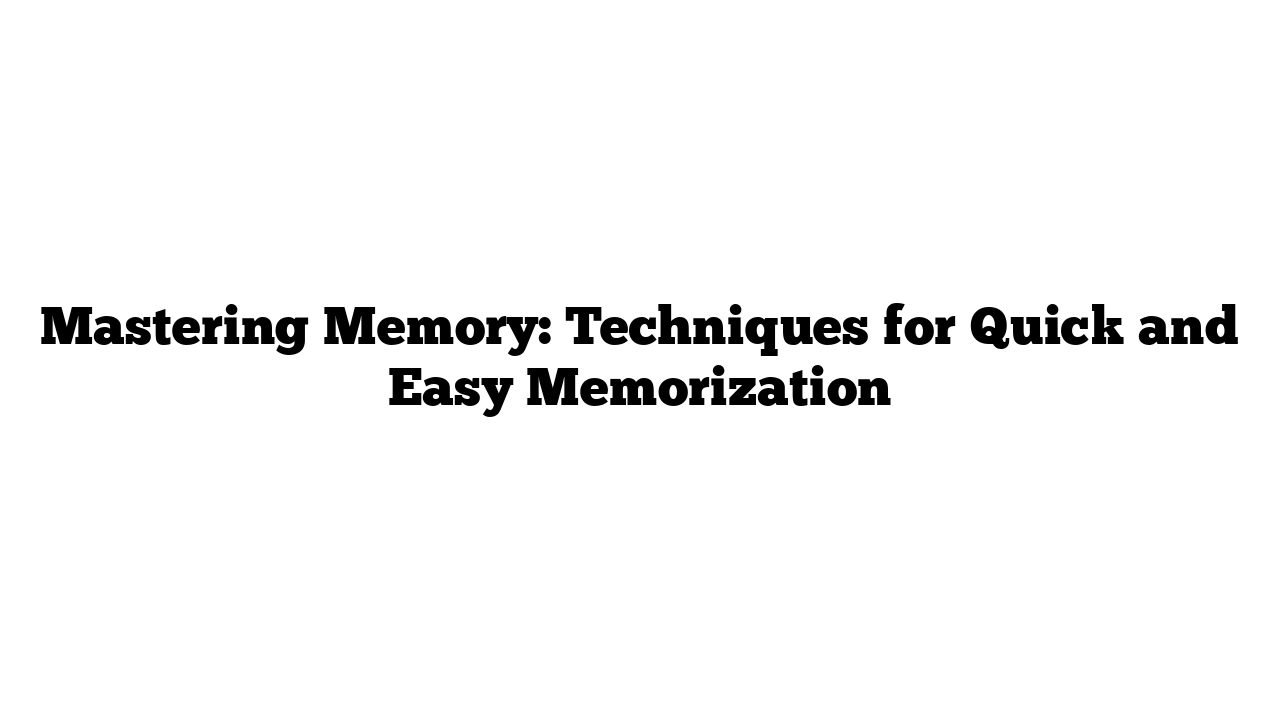Whether you’re preparing for an exam, learning a new language, or just tired of forgetting names and faces, enhancing your memory can make life easier. Memory expert Aaron Tupaz, with over a decade of experience in memory techniques, shares insights on how to memorize anything faster. In this article, we’ll break down proven techniques, from chunking information to creating mental associations. Let’s dive into the powerful tools that will help you retain information like never before.
The Foundation of Memory: Three Key Principles
Eight-time world memory champion Dominic O’Brien emphasizes three core principles to mastering memory: Association, Location, and Imagination.
1. Association: Building Connections
Our brains are naturally wired to link ideas together, like a mental map. Often, we don’t fully forget memories but lose the “path” to access them. Think of it as a chain of dominos—if one falls, the chain collapses. The goal is to create strong, multiple connections so that even if one link fades, you can still retrieve the memory.
Tupaz explains, “Using association is about creating durable links to make memories more accessible.”
2. Location: Memory Palaces
Known as the “method of loci” or the memory palace, this technique taps into our excellent spatial memory. Visualizing information in familiar places, such as rooms in your home, helps store memories effectively. For short-term storage, try creating three memory palaces—spaces you can cycle through, like your home or favorite places in a game. To start, divide your home into 10 areas, number them, and imagine storing different memories in each area.
3. Imagination: Make It Vivid
We remember unusual, funny, or even strange things more easily. By involving as many senses as possible, you create strong, memorable associations. Experiment to find what works best for you; vivid and exaggerated details tend to stick better.
Chunking: Breaking Down Information
If you were asked to memorize random letters, such as “F B I C B S I B M I R S,” it’s easier to remember them as familiar chunks: “FBI,” “CBS,” “IBM,” “IRS.” This technique, known as chunking, reduces the load on your memory. By chunking complex information, you can simplify learning large amounts of data, such as numbers, vocabulary, or sequences.
Using the Peg System: Assigning a unique character to each number helps build strong associations. For example:
- 25 = Santa Claus (Christmas is on the 25th), whose action could be “giving a gift.”
- 07 = James Bond (007), with the action of “holding a gun.”
Combine these characters to tell a memorable story, placing them in a specific location in your memory palace. This approach can be adapted to memorize anything from credit card numbers to birthdays.
Techniques for Remembering Different Types of Information
Memorizing Vocabulary: The Method of Loci
Learning a new language? Store vocabulary words in distinct locations. For instance, store feminine words indoors and masculine words outdoors. For the Spanish word carne (meat), imagine a car with wheels made of meat inside your school cafeteria. This vivid, creative scene helps the word stick.
Names and Faces
To remember names, associate each new person with someone you already know by that name. Visualize an interaction between the two people in the location you met the new person. For unique names, get creative with associations. To remember faces, focus on unique features and exaggerate them. If someone has pointed ears, imagine them with a character like Spock.
Directions and Spatial Memory
To recall directions, use simple images for left and right. For example, a rabbit for “right” and a lion for “left.” Visualize a rabbit by a gas station if you need to turn right, then picture a lion jumping over a stop sign for a left turn. This approach helps create a mental “breadcrumb trail” to navigate unfamiliar areas.
Remembering Speeches with Loci
Public speaking often tops the list of common fears. The method of loci is ideal for remembering a speech’s structure without cue cards. Picture each part of your speech in a familiar location, like a path through a park, and place images along the way as reminders of each topic.
Memorizing a Deck of Cards
To remember a deck of 52 cards, assign each card a character and action. Divide them into rooms within your memory palace and create a story in each room to connect the cards. With practice, you can memorize a deck in under a minute by using this visual storytelling method.
Everyday Hacks: Finding Your Parked Car and Wallet
To remember where you parked, imagine a vivid scene, like your car crashing right after parking. The broken glass and dramatic details will help the spot stick in your memory. For your wallet, picture it as a dangerous object, like a grenade, and imagine it “exploding” wherever you set it down. The mental image makes it harder to forget where you placed it.
Review and Reinforce for Long-Term Memory
Without review, memory traces can fade in days or weeks. By reviewing a few times in the first month and then every few months, memories can stay vivid for years. Tupaz says, “With consistent review, these techniques allow you to retain anything from historical dates to complex equations.”
Expanding Memory Beyond Basics
These techniques can be applied creatively. Use them to memorize your opponent’s poker hands, remember advanced math equations, or impress friends by recalling every detail of your conversation. The key is to think outside the box and integrate these methods into daily life.
Final Thoughts: Empower Your Memory
Memory is a skill that can be trained and improved. With dedication and practice, these techniques allow anyone to memorize faster and more effectively. To explore more memory strategies, visit medicaltimes.io.
By mastering these techniques, you’ll be on your way to building a sharper, more reliable memory for a lifetime.
